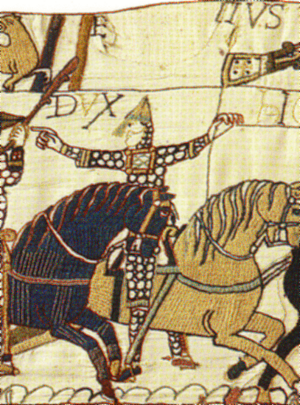Turstin FitzRolf facts for kids
Turstin fitz Rolf was an important knight during the Norman conquest of England in 1066. He was also known as Turstin le Blanc or Tustein fitz Rou. He is one of the few people known for sure to have fought alongside William the Conqueror at the famous Battle of Hastings.
Turstin came from a place called Bec-de-Mortagne in Normandy, which is a region in modern-day France.
Contents
What's in a Name?
Turstin's name, "fitz Rolf," means "son of Rolf." The word fitz comes from an old French word for "son." His father's name was Rolf, which is similar to "Rollo."
The name Turstin comes from the Old Norse name Þórstæinn, which means "Thor's stone." You might also see his name spelled as Tostein or Thurstan.
A writer named Wace wrote a poem about Turstin. He said that Turstin fitz Rou the White lived in Bec-en-Caux. This shows us where he came from.
Fighting at Hastings
Turstin played a key role at the Battle of Hastings. A writer named Orderic Vitalis said that Turstin carried the "standard of the Normans." A standard was a special flag that showed who was in charge.
Another writer, Wace, told a story about Duke William trying to find someone to carry his standard. The Pope had sent this special flag to William.
First, William asked Raoul de Conches to carry it. Raoul said no, because he wanted to fight with his own hands. Then, William asked Walter Giffard. Walter was older and also said no, saying he had many knights to lead.
William became angry, thinking his knights might betray him. But Walter explained he wanted to fight hard for the Duke. Finally, William called out for a knight named Tosteins Fitz-Rou le Blanc. Turstin was happy to carry the standard. Because of this, his family later received special benefits for their land.
Some people think Turstin is shown in the Bayeux Tapestry carrying the standard. However, the knight in the tapestry is more likely Eustace II, Count of Boulogne. The tapestry has a label that looks like "Eustace." This knight is also shown talking to Duke William and pointing backward, suggesting a retreat.
Another writer, William of Poitiers, wrote that Eustace of Boulogne tried to tell Duke William to retreat. But the knight in the tapestry is clearly holding a flag with a cross, which looks like the Pope's banner. So, it's still a bit of a mystery!
Land in England and Wales
After the Norman Conquest, Turstin was given many lands in England. These were rewards for his loyalty and service to William. The Domesday Book of 1086 lists all the lands he held.
Turstin held a large area of land called the Barony of North Cadbury in Somerset. This included many smaller areas of land, called manors, in nearby counties.
He also held land near Caerleon in Wales. This area was close to the border between England and Wales. Turstin's land here had some Welsh people living on it who kept their own customs. He also owned property in Chepstow, which was an important crossing point over the River Severn.
Lands from the King
Turstin received many lands directly from King William. Here are some examples:
- In Gloucestershire: Alvington, Ampney Crucis, Fretherne, Hillesley, King's Stanley, Oakley, and Tortworth.
- In Somerset: Blackford, Little Keyford, Maperton, North Cadbury, Pitcombe, South Cadbury, Syndercombe, and Woolston.
- In Berkshire (now mostly Oxfordshire): Sparsholt, Coleshill, Childrey, and Upton.
- In Buckinghamshire: Little Kimble and Hardwick.
- In Dorset: Gillingham, Allington, Nyland, and Stoke Wallis.
- In Herefordshire: Little Marcle.
- In Hampshire: Newton Valence.
Lands from Other Important People
Turstin also held lands from other powerful figures:
- From the Bishop of Worcester: Aust and Gotherington in Gloucestershire.
- From the Abbot of Westminster: Hasfield in Gloucestershire and Eckington in Worcestershire.
- From Walter Giffard, a fellow Norman knight: Great Missenden in Buckinghamshire.
What Happened Next?
Wace's poem mentioned Turstin having "kindred" and "heirs." However, we don't have clear records of his family inheriting his lands in England. Some sources say Turstin had a son named Ralph, who died during a crusade to the Holy Land.
Most of Turstin's lands did not go to his son. Instead, they went to another Norman lord named Wynebald de Ballon. It's not clear why this happened. Perhaps Turstin died without a direct heir, or maybe he lost the king's favor.
It's possible that Turstin supported Robert Curthose, who was William the Conqueror's oldest son. Robert tried to take the English throne from his younger brother, William Rufus. If Turstin supported Robert, he would have been on the losing side. People who lost in these power struggles often had their lands taken away. This happened to some of Turstin's neighbors in 1088.
Sources
- Transactions of the Bristol & Gloucestershire Archaeological Society, 1879–80, vol.4, On the Landholders of Gloucestershire Named in Domesday Book, by Alfred S. Ellis, esp. chap. LXVII, TVRSTINVS FILIVS ROLF, pp. 186–188 (www.bgas.org.uk)[1]
- www.domesdaybook.co.uk; [2]
- Douglas, D.C. & Greenaway, G.W. (eds.) English Historical Documents 1042-1189, London, 1959.


